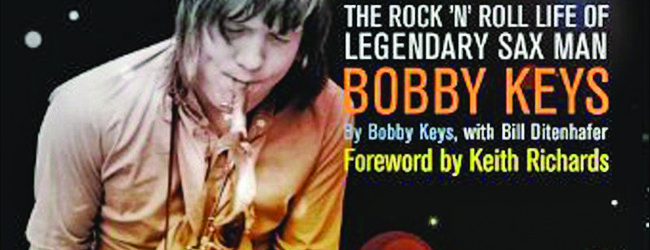
Every Night’s a Saturday Night: The Rock ‘n’ Roll Life of Legendary Sax Man Bobby Keys was recently released by the legendary saxophone great, who was possibly most famous for playing nearly every well known piece of saxophone on The Rolling Stones’ recordings and tours.
“My most treasured friend, this beloved maestro is going to take you on a rock ‘n roll journey that will leave the reader gasping.” An impressive and accurate description of Bobby Keys’ new autobiography in a foreword written by friend Keith Richards, Every Night’s a Saturday Night describes Keys rise to legendary status in the world of rock ‘n roll.
Bobby Keys talks about being captivated by rock ‘n roll from a young age. At ten, Keys heard Buddy Holly playing for the opening of a local gas station. “I was just drawn to that sound – it was the first time I’d ever heard anyone play an electric guitar live.” Keys claims that “it was like a mountain had fallen on me” and it was something that he knew he had to be a part of. Keys started by bribing his way into Buddy Holly’s garage with burgers and cokes, which was conveniently located down the street from his grandparent’s home in Slaton, Texas.
Originally, Keys had hoped to be a guitarist, but explains that the only instrument left in the school band was the saxophone. He picked up the instrument and put his heart into learning to play. One can only assume such an event was a combination of passion, practice and fate, as rubbing elbows and playing with legends like Buddy Holly quickly became the norm for Keys. “Call it divine intervention, fate, whatever, but rock ‘n roll and I came of age together.”
In 1964, at the age of eighteen, Keys got a huge surprise when he showed up to cover for another musician and found himself recording with Elvis Presley. Presley is just one of many legendary rockers that Keys has played next to. John Lennon, Joe Cocker, Eric Clapton, Lynyrd Skynyrd, and The Rolling Stones represent only a fraction of his musical resume. Keys spends a lot of time talking about the musicians and bands that he played next to, especially The Rolling Stones. Mick Jagger and Keith Richards still share a strong friendship and bond with the sax player. Keys was Jagger’s best man when he married Biana Perez-Mora in 1971.
The legendary sideman doesn’t just talk about the musicians that he met and befriended, but also about the lifestyle they led. Keys reminisces about some of the more common recreational activities among musicians, such as drinking, smoking marijuana, and getting into trouble. His honesty in these matters is refreshing, “I was always drawn to the forbidden fruit…I never tried to claim otherwise.” This candidness coupled with the wild and crazy narrative of his life makes Key’s book ideal for someone looking for an insight into the development of rock n’ roll.

